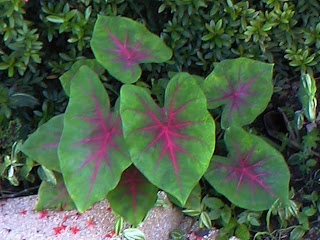
It seems that the name of the genus is the Latinization of the name in Malay language “kaladi”; the name of the species comes from the Latin “bicolor” = of two colours, with obvious reference.Common names: “caladio”, “caladium” (Italian); “angel wings”, “elephant’s ear”, “fancy-leaf caladium”, “heart-of-Jesus”, “mother-in-law plant” (English); “caladium”, “palette de peintre” (French); “caladio”, “coração-de-Jesus”, “papagaio”, “tajà”, “taià”, “tajurà”, “tambatajà”, “tinhorão” (Portuguese); “alas de angel”, “caladio”, “capotillo”, “corazon de Jesus”, “manto de la reina”, “orejas de elefante”, “paleta de pintor” (Spanish); “Buntblatt”, “Buntwurz”, “Kaladie” (Ger- man).
Deciduous, rhizomatous, perennial herbaceous, with peltate, sagittate or hart-shaped leaves, of various tones of green and variously spotted, veined and dotted of red, pink and white, 20-40 cm long and 10-20 cm broad on fleshy petioles, long up to about 60-70 cm, directly from the rhizomes.
The inflorescences, rather negligible and shorter than the leaves, are formed by a 6-10 cm long spadix, narrowed in the median part, contained in a yellowish white spathe tending to the green at the base; the flowers are unisexual, the masculine ones occupy the upper part of the spadix for 3-5 cm of length, the feminine ones are grouped in the lower part for 1-2 cm of length, separated from the masculine ones by a sterile zone of about 2 cm.
Plant poisoning is caused by chemicals in plants that have undesirable affects upon animals and humans. Some poisons must be ingested whereas others, such as chemicals in poison-ivy, only require contact to elicit response in sensitive humans. Some chemicals must be modified before they are poisonous to animals, such as prunasin and other cyanogenic glycosides.
Plants that cause dermatitis are discussed in this program if the reactions are severe. The more obscure dermatologic plants are not included. For more information on plant-induced dermatitis [see Mitchell, J. C., Rook, A. 1979. Bota
nical dermatology. Greenglass Ltd, Vancouver, B.C., Canada. 787 pp.].
Other excluded plants are those that only cause mechanical injury, poisonous blue-green algae, and plants causing hay fever.
While the Information System is oriented primarily to a Canadian audience, much of the information is useful elsewhere. Certainly the plants grown in and around homes can be grown throughout the temperate regions of the world. Indeed, many house plants are tropical in origin. Other plant species included here have been introduced to North America as well as other temperate regions of the world. The information on the native plant species is applicable wherever they grow in North America.
Elsewhere, it is cultivated as annual, pulling out the tubers from the ground in autumn, as soon as the leaves have fallen, in order to conserve them in sand or other inert material in a dry and ventilated location, with temperatures not lower than +12°C, treating, if the case, with fungicides, and to enter them again by the beginning of spring, when the temperatures are favourable.
The plant, more particularly its countless hybrids and varieties, is also cultivated, since long time, in pot for indoor decoration, paying attention to keep constantly humid the substratum during the vegetative period, and to stop completely watering during the resting time, when the plant loses its leaves, and resuming them after the vegetative recommencement.
All the parts of the plant contain toxic substances, particularly calcium oxalate, which can cause reactions, even serious, if chewed and swallowed.
I don't mind much seeing my photographs been used by others... but at least would be nice to mention from where the image has been taken, http://muchaplanta.blogspot.com.es/2012/07/commelina-variegada-asiatic-dayflower.html
ReplyDeleteThe Caladium sown here was grown by me almost twenty years ago and the image was taken with my first digital camera, a big, expensive and almost primitive JVC... :) Those were the days.
michael kors handbags
ReplyDeletecheap nhl jerseys
michael kors handbags
michael kors handbags
replica watches
cleveland cavaliers jersey
ugg boots
hugo boss sale
michael kors handbags
true religion outlet
Finally I've found something which helped me. Thank you
ReplyDeletehttp://www.prokr.net/2016/09/ceramic-polishing-companies-2.html
http://www.prokr.net/2016/09/ceramic-polishing-companies.html
nike sneakers
ReplyDeleteoff white shoes
supreme clothing
kyrie irving shoes
ferragamo sale
yeezy
curry 5
coach outlet store online
kyrie 6
golden goose slide
xiaofang20191226